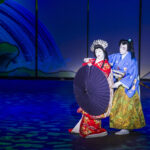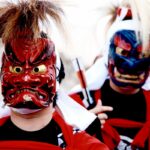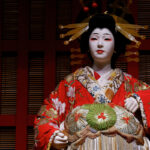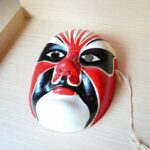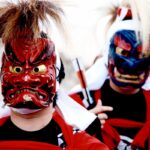Kabuki is a famous and well-loved art form that hails from Japan. It is a wonderful traditional art that dates back to the early 1600s, when a woman named Izumo no Okuni conceived it.

This unique performance is a type of Japanese theater, which combines several elements such as drama, music, dance, and pantomime.
The performers are known for their exaggerated and eye-catching looks, as well as their dramatic acting and movements.
Going to any kabuki performance, you may see a variety of masks, costumes, and extreme makeup looks. All of these are used to set characters apart and give viewers a memorable experience while telling fun and fascinating stories.
These stories may include conspiracies, tragedies, love stories, moral conflicts, historical events, and a number of other well-known legends and stories.
Anyone who has ever had the pleasure of seeing a kabuki performance in person may have a lot of questions about this art form! For one, you might wonder who came up with the idea and started the whole thing.
Well, thanks to historical texts and documents, we do know who created kabuki, and her name was Izumo no Okuni. If you want to find out more about this incredible woman, just keep reading.
Who Created Kabuki?
Early records from the 1500s-1600s reveal that a woman named Izumo no Okuni was the mind behind kabuki. Its beginnings were humble, and groups initially performed light sketches in and around Kyoto.
However, as Japan changed and the Tokugawa Shogunate gained more control of the country, this art form quickly changed into what it is today.
Izumo No Okuni
Sometimes just known as Okuni, little is actually known about the founder of kabuki. There are a number of sources such as diaries, drawings, and paintings that have been studied regarding Okuni, but her life largely remains a mystery.
It is difficult to determine the validity and accuracy of the information we have about Okuni. However, there are some key pieces of information that we will dive into in the sections below.
Why Was Kabuki Created?
To understand why kabuki was founded, we need to have a basic understanding of Japan at the time.
Before the Tokugawa Shogunate (1600-1868), theater performances were primarily meant for the aristocrats and wealthy citizens of Japan. Performances were serene and stately, known as noh (to learn the difference between kabuki and noh theater, read here).
Because of this, there was no set performance or entertainment for the common people. Noh was reserved for the higher classes, and there was no equivalent for the large working or common population.
It was thanks to this that kabuki was founded. This art form was meant to serve as entertainment for the common people.
However, performances also allegedly had strong links to prostitution, and the women that make up the dancing and acting troupes were deemed as prostitutes.
This ultimately led to the shogunate enforcing bans and altering the rules and regulations surroundings performances, which we will cover later on.
About Izumo No Okuni
Izumo No Okuni’s Life Of Kabuki
According to records, Izumo no Okuni was an attendant at the Grand Shrine of Izumo. While her exact role is not known, the common theories suggest that she was either a prostitute or a temple dancer.
In 1603, Izumo formed a troupe of all-female dancers and actors. This group went on to give the people incredible popular dance performances and light sketches on the Kamo River’s dry riverbed in Kyoto.
These performances were vastly different from the noh dramas that were popular among aristocrats. Her performances were more lively, and captured the attention of all who attended.
It was even said that Okuni herself would dress as a young man as she performed select dances, which only drew in more people.
As this style of performance grew in popularity, Izumi began arranging a variety of similar events. It didn’t take long for the unrestrained and lusty dance dramas to become known all around the country, and they got the name Okuni Kabuki.
What We Know About Izumo’s Life
It is thought that Izumo was born sometime in the 1500s to a blacksmith a short distance from the grand shrine in the Shimane prefecture.
Because of her proximity to the temple, Izumo likely grew up with a love of the temple and serving the people around her.
As she grew up, she became a miko (shrine maiden) for the shrine. She also performed sacred dances and was trained from a young age to be a priestess of the temple.
Thanks to her skills as a dancer, it is said that onlookers would be in awe of her beauty and talents. However, something unknown stood in her path of success.
While she was able to spread kabuki throughout Japan with the help of her dance troupes for a decade, her name is not one that is widely known.
Izumo was supported financially by Nagoya Sansaburo, but no one is certain if the two ever had a romantic relationship. She managed to perform with her dance troupe until she retired around 1610.
However, it was around this time that she also disappeared without a trace, and it is thought to have died within the next few years.
Her exact age or birthday was not known, and some claim it was the early 1500s, while others sometimes claim around 1578.
Based on the fact that Izumo would be in or close to her hundreds if she was born in the early 1500s, the latter option is more widely accepted.
The Shogunate’s Influence On Kabuki
Kabuki, as it was when it was first founded, did not last long. While we know that this art form was created by a woman, the Tokugawa Shogunate banned women from performing it on stage in 1629.
They turned it into an all-male theater group, and men quickly took up every role and character in a performance.
This ban happened because the shogunate deemed the theater performance immoral practice for women. Kabuki was full of sensuous dances and characters, and the actors were known to participate in prostitution.
These elements proved to be too disruptive for the shogunate, leading to women being banned from the art form.
Kabuki did not fade once women were banned, however. Instead, this led to the roles being taken up by young men up until 1652.
In that year, this worm of kabuki was also suppressed due to the government’s concerns over morals. From then on, the roles were taken over by older men.
It is this form of kabuki that we are all familiar with today. Although performances have become more sophisticated over time and the acting has, in many ways, grown more subtle, this is an art form that is loved and appreciated today.
Final Thoughts
Kabuki has transformed throughout the years since it was first formed by Izumo no Okuni in 1603. However, little about Izumi’s life has been verified through texts and art.
Despite this, this art form has stood the test of time and has remained a tremendously popular and well-loved performance type to this day.
- 16 Best Websites To Watch Japanese Movies With English Subtitles - May 11, 2023
- Is ZIPAIR The Best Airline For Traveling To Japan? - May 11, 2023
- Ryu Murakami Vs Haruki Murakami – Which One Should You Read? - May 11, 2023

